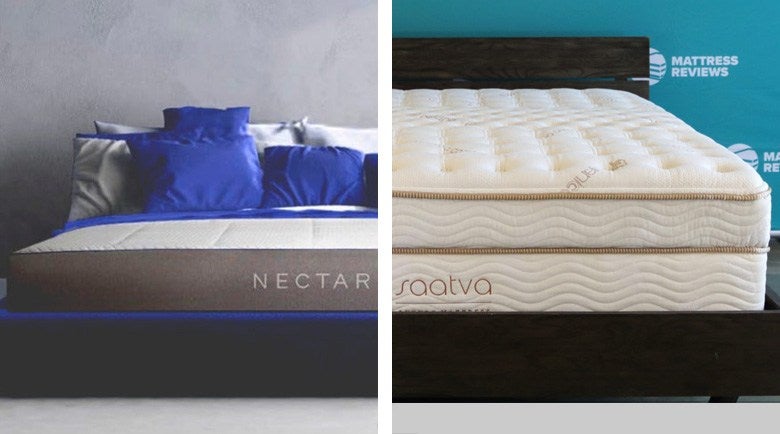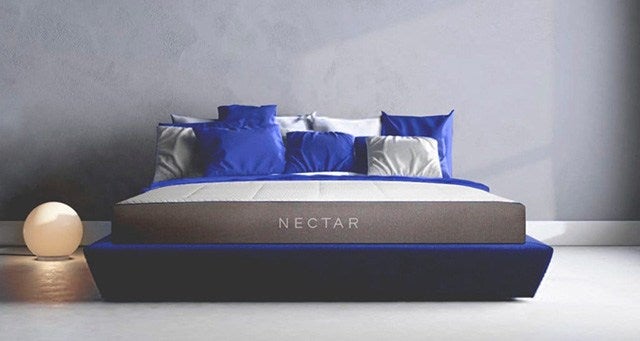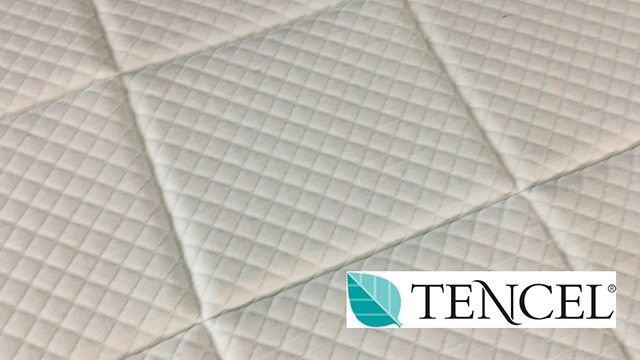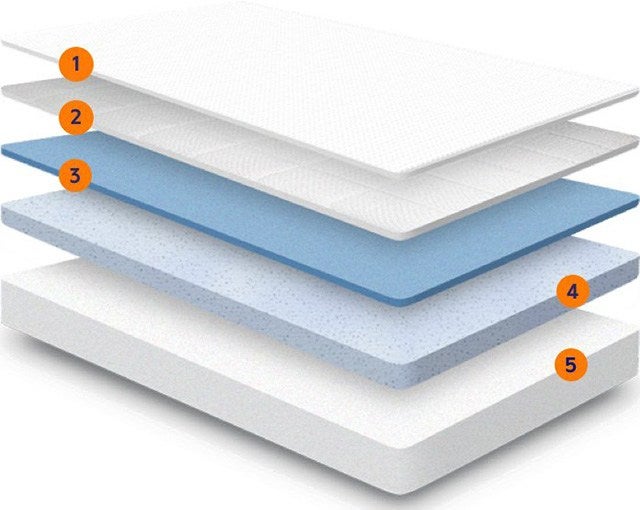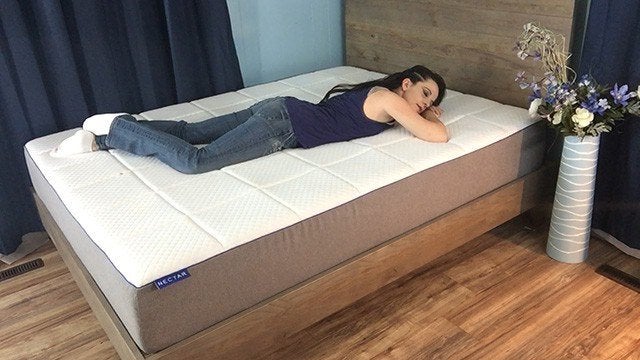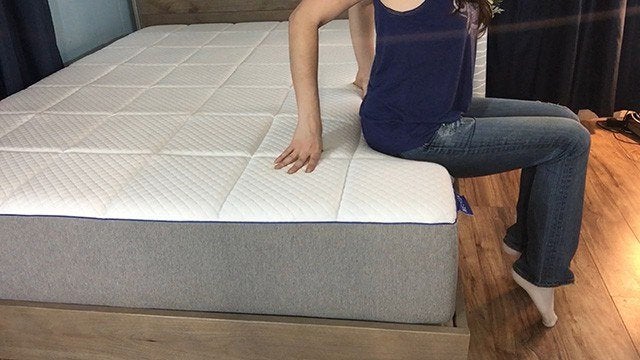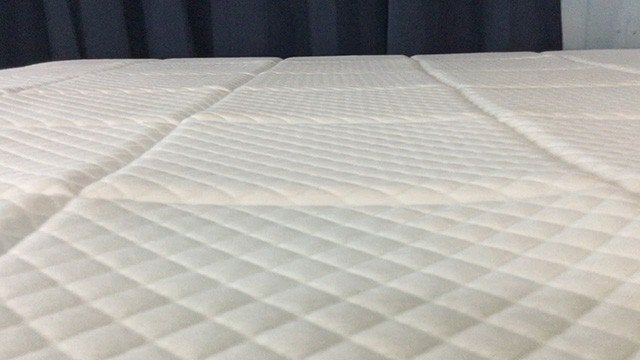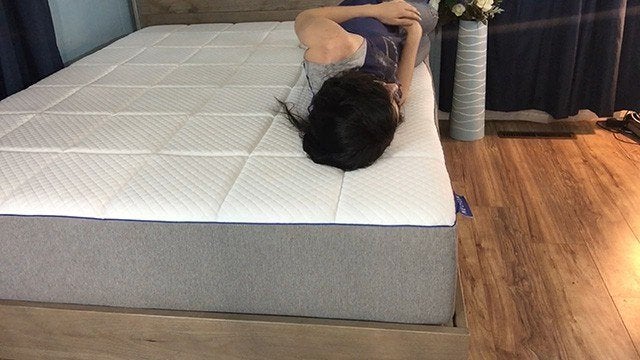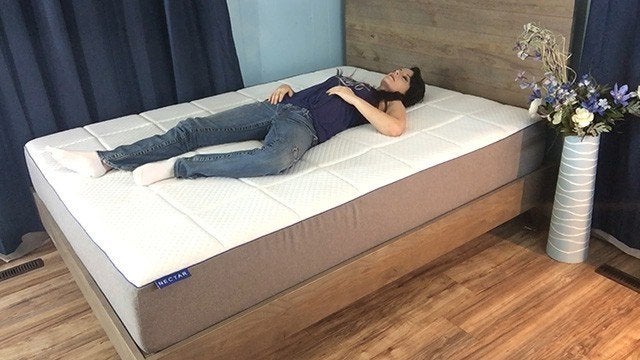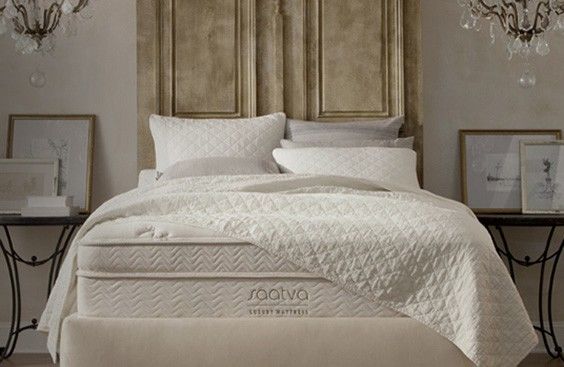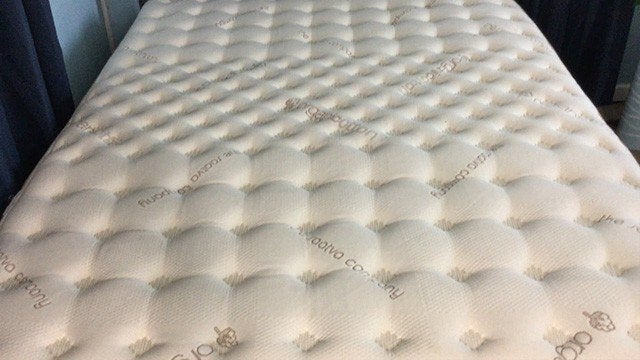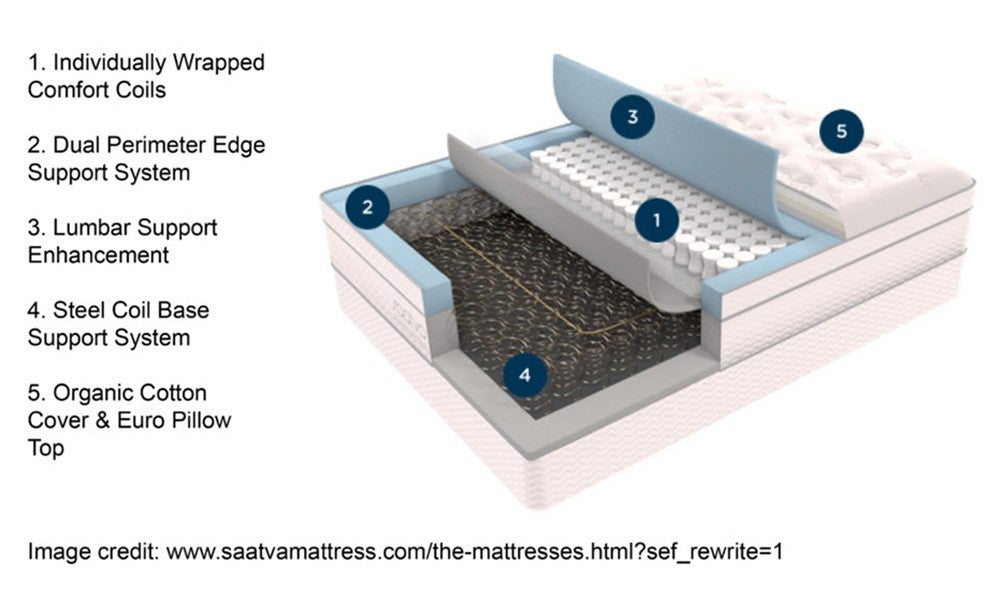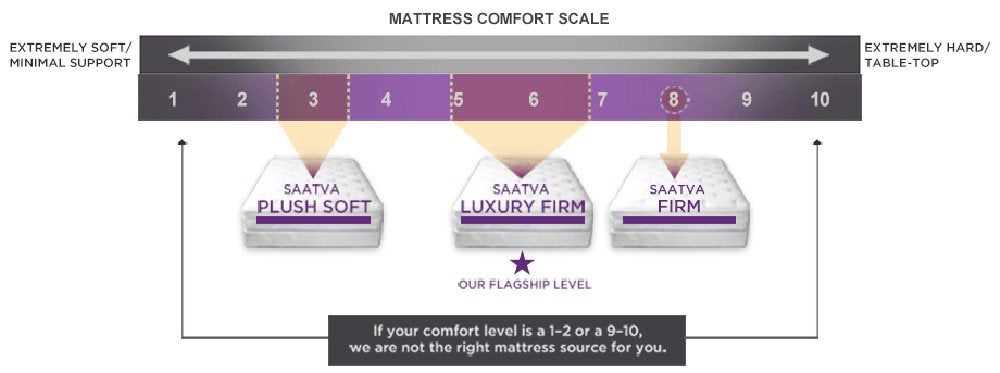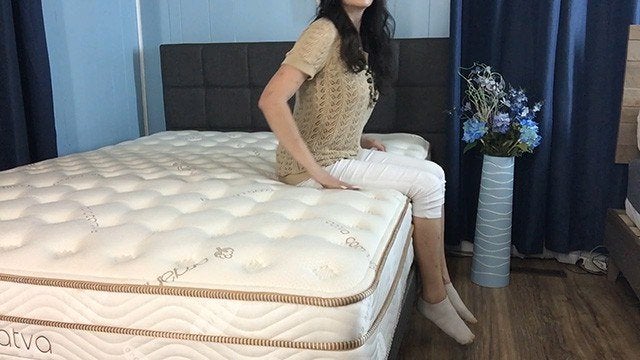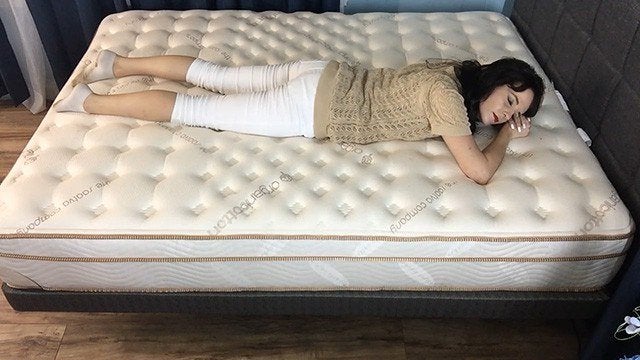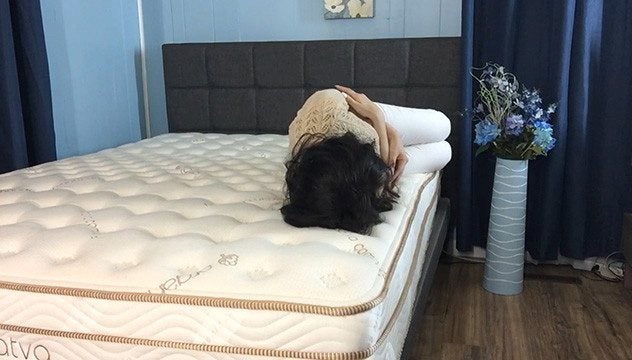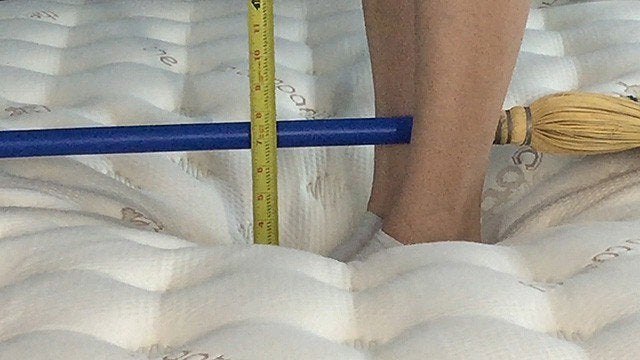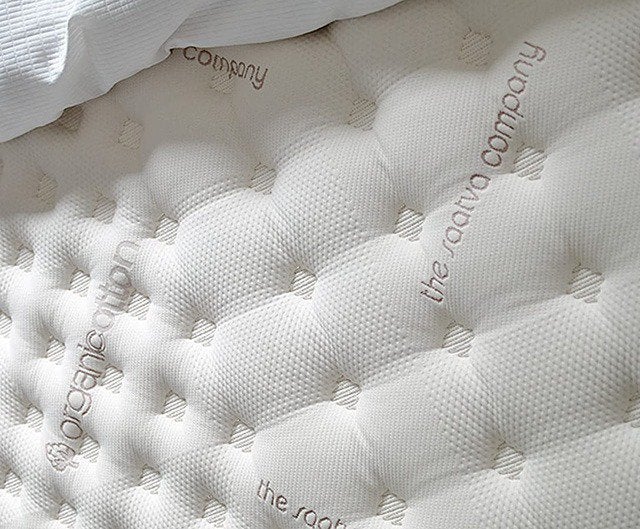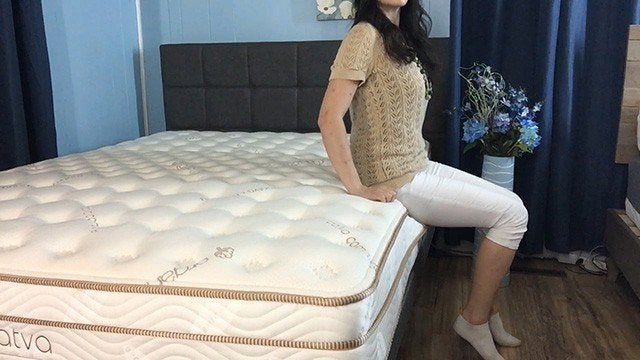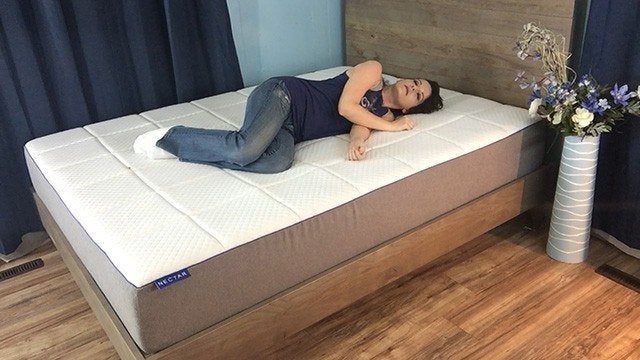One of the major issues associated with memory foam is that it tends to sink and wrap around your body – this keeps many consumers from getting a viscoelastic mattress, despite the gains its offers in terms of pressure relief and adaptability to one’s sleep posture.
Many mattress makers have attempted to solve the sinkage problem – Nectar is one manufacturer that sticks with an all foam construction but tries to reduce sinkage through an extra stiff support core, while Saatva has taken the hybrid route – they’ve combined viscoelastic with spring structure to yield both conformity and resilience.
This Nectar vs Saatva comparison explores the features of each mattress with respect to each other – by the end of it, you will have a better idea of which approach is more suitable for your sleep needs.
Nectar Breakdown
The Nectar can be termed a conventional memory foam mattress based on the multiple generous layers of viscoelastic it employs, however, it does shake things up a little with its quickly hardening lower layers.
Construction
Cover
The Nectar sports an organic cover: it uses Tencel® fabric that is itself composed from eucalyptus pulp. This material is soft and skin-safe just like cotton, and even more breathable. In this regard, the Nectar and the Saatva are evenly matched – both have organic covers, however, the Nectar takes a slight edge because of the extra moisture absorbency it achieves because of Tencel’s superior breathability.
First Layer
The first layer of the Nectar is composed of one inch of quilted gel memory foam. It has a low 14 ILD rating to achieve a highly contouring and plush initial response for the mattress, so that your posture is accommodated and pressure removed from your joints and muscles. Thanks to the inclusion of gel in the foam, it is able to take your body heat away better than ordinary memory foam can.
Second Layer
The succeeding layer is also composed of viscoelastic gel foam, but the manufacturer has upped the ILD to 15 and increased the thickness to 3 inches. This part of the mattress takes the brunt of the initial pressure exerted by your body, and is responsible for conforming to the deeper contours that your body makes.
The thickness also means that the impact is absorbed for the most part at this point, preventing excessive further sinkage.
Third Layer
This 0.5” layer of Adaptive Hi-Core foam is responsible for connecting the two soft layers of memory foam above it with the hard support layer below. It is, however, slightly less yielding as far as transition layers go at its 45 ILD rating. The idea is that this layer will provide some resistive lumbar support while also being adaptive to your body to some extent.
Fourth Layer
The base layer of the mattress made from extra stiff 55 ILD polyurethane foam at a thickness of 5.5 inches and a density of 2.2 lbs./cu.ft. Thanks to its robust, extra-stiff construction, it is able to yield higher than average resistance for your entire body frame, so you feel better supported overnight compared to mainstream memory foam products.
Firmness and Feel
Medium-firm is the only firmness level that the Nectar comes in, and it is meant to be sufficient for the sleep requirements of most consumers.
Comfort and Support
The medium-firm firmness level of the Nectar is an almost even combination of plush viscoelastic conformity and stiff, unyielding polyurethane support. What this means in simple terms is that you’ve got a memory foam mattress that will be less enveloping around your body than most of its contemporaries, without losing the essence of the material.
Having said that, since this is an all-foam product, it will still be considerably more adaptive and yielding that the Saatva, which uses a sparse amount of memory foam in conjunction with two steel coil layers.
Edge Support
Given that this is a memory foam mattress, you shouldn’t have high expectations from the Nectar when it comes to keeping you well supported as you sit on the edge of the bed. However, it does surprisingly well in this domain thanks to it the stiffness of its last two layers, which together prevent your body from sinking in too deep at the sides.
Cooling
Thanks to the enhanced heat dissipation of the high quality gel foam present in the upper two layers of the Nectar (which is incidentally of medical grade standard), and the breathability afforded by the Tencel® cover and the air channels in the base, the Nectar is able to keep its temperature surprisingly low for a viscoelastic product – in fact, its performance is on par with the Saatva!
Naturally, because of the inherent cradling action of the memory foam, some of the more temperature sensitive sleepers may find it hotter than it actually is.
Motion Transfer
Unique Features
Cheap
Despite the fact that it uses high quality foam in its construction, sports an organic cover, and has remarkably open-ended return and trial policies, the Nectar is priced significantly less than what is considered average for mattresses in its league. It is certainly cheaper than the Saatva, and as a memory foam product, it packs a ton of value for the features it incorporates.
Tencel® cover with superior breathability
The Saatva also has a fully organic cotton cover, but the Tencel® fabric which is present in the Nectar’s cover exceeds the former when it comes to breathability. This gives it an edge for assisting sleepers who have a sweating disorder, and in fact, enables it to be slightly cooler than the Saatva (a big surprise considering that the Saatva is an innerspring hybrid that uses very little memory foam!).
Classic viscoelastic response with lesser enveloping
Although it is a memory foam mattress in every regard, the Nectar attempts to mitigate a frequent complaint with this material: that it starts to sink under your weight over time, to the point that you find yourself in a cradle, which becomes particularly noticeable when you adjust your sleep position.
It does through the introduction of a stiff layer of Hi-Core Adaptive memory foam – a robust, resistive yet contouring material that gives the mattress some stiffness overall and enhances the lumbar support too.
Extended trial period
The Nectar comes with a 365-day trial period compared to the Saatva’s 120-day trial period. It is interesting that the Saatva was one of the pioneers of these money back guarantee trials, but now has been outmatched by a competitor that is cheaper in price too. Regardless, with a yearlong trial, you’ve got plenty of time to decide if the mattress is suitable for your needs.
Lifetime warranty
Again, remarkably impressive for its price tag, the Nectar comes with a lifetime warranty (whereas the Saatva only has 15-year policy). I normally consider even a 15-year policy to be overkill, so the lifetime policy is above and beyond. More importantly, it shows that the manufacturer has serious confidence in the durability of their mattress.
Saatva Breakdown
The Saatva, as mentioned at the outset, is a hybrid mattress that combines a memory foam comfort layer with a unique coil-on-coil underlying structure, to capture the soft, contouring response of the former as well as the stiff, resilient behavior of the latter.
Construction
Cover
The Saatva’s cover is made from pure organic cotton (a material known for its softness and breathability), and it is stretched tightly to fit over all the layers that make up the mattress. Besides giving it a clean aesthetic, the stretching also ensures that there is no wrinkling or bunching that could disturb you during sleep (pure cotton tends to develop wrinkles quickly).
Euro Top
Immediately following the cover is a 1.25 inch plush Euro top comprised of thick memory foam. It gives the initial pressure relief that is needed by one’s body after it lands on the bed. The memory foam also ensure that the mattress is able to adapt to your posture, which further enhances the pressure relieving aspect.
Although normal pillow tops look like added appendages on a mattress, the Euro pillow top is fitted flush with the mattress, so that it looks like a natural part of the whole.
First layer
This is the first actual layer of the mattress (in that it is completely glued to the preceding layers). It is simply a thin slice of memory foam (just 3/8” thick!) that is meant to add some padding between the Euro top and the underlying dual coil layers. Besides adding to the contouring response generated by the Euro top and providing some intermediate support for your lower back, it also prevents you from feeling the hard steel of the springs.
Second Layer
This layer comprises of pocketed springs encased in special edge support foam. These springs are able to respond to the application of pressure independently of their neighbors, so that the support they yield is tailored to your sleep profile (something that is not possible with ordinary interconnected springs, such as those present in the subsequent layer). They are 4 inch long and 14-gauge thick.
The edge support encasement bolsters the support at the sides of the mattress, so that you don’t experience sinking and slipping when sitting at the edges.
Third Layer
This layer is made from interconnected steel coils at a length of 7 inches and a thickness of 13-gauge. The added thickness (smaller gauge means more thickness) and length is in line with the unyielding support that this layer is supposed to provide to your body as it rests overnight. This ensures that there is no further compression that could put awkward strain on parts of your body that could in turn lead to pain in the morning.
Edge Support Border
As if the stiffness of steel springs and the edge support encasement of the pocketed coil layer wasn’t enough, the manufacturer has also included a dedicated border around the mattress whose only purpose is to ensure that the mattress is able to support your weight while you sit on the edges. This is above and beyond compared to most other mattresses (the Nectar can’t keep up with this either).
Firmness and Feel
There are three separate firmness options available for the Saatva, and each is designed to yield a specific blend of pressure relief and reactive support. However, since all of them are essentially innerspring / viscoelastic hybrids, you can expect the overall behavior to be much more resilient than the Nectar.
A 1-10 scale is used to express the firmness level of these variants by the manufacturer. 1 is extremely soft like quicksand, and 10 is extremely hard like a wooden tabletop.
Comfort and Support
Plush
This is the softest version of the Saatva, and this is reflected in its humble overall ILD rating of 18. This model maximizes the pressure relief and adaptability part of the overall response, while reducing the stiff behavior of the steel coil layers. Thus, the mattress produces more soft bounce than hard spring, and is more readily contouring to your sleep posture.
The Plush model has a rating of 3 on the 1-10 scale I’ve described above.
Luxury Firm
This variant is balanced between pressure relief and support: it equally emphasizes both the contouring output of the memory foam layers and the reactive pushback of the lower spring layers. Thanks to this balancing act, the mattress is able to address the needs of virtually all sleep styles (provided that the sleeper is normal weight). As a consequence, this is Saatva’s most popular variant.
While the manufacturer keeps the exact ILD rating concealed to prevent others from cloning it, they describe the firmness as lying between 5 and 7 on the 1-10 scale.
Firm
This variant has an overall ILD rating of 30 – which means that it is pretty close to the response of a true innerspring mattress: there is a clear focus on the springy behavior of the coil-on-coil structure, and a similarly clear reduction in the response of the upper viscoelastic layers. That being said, the Firm variant is still not completely devoid of adaptiveness – even the layer of pocketed coils ensure that there is some always present.
Edge Support
I’ve already described the edge support improvement features that the manufacturer has put in place for this mattress – neglecting the fact that the innerspring core in itself is quite stiff and supportive! In a nutshell, the Saatva offers some of the best edge support seen in hybrid mattresses, so you can sit comfortably on the side of your bed for as long as you want.
Even if you’ve got some serious bulk, you’re covered by the extra resilience afforded by the Firm variant of the mattress.
Cooling
The cotton cover is good at ensuring that heat is transmitted down into the lower layers of the mattress instead of bothering you at the surface, and the two spring layers are naturally able to allow the passage of air. It is the (comparatively) small amount of memory foam between these layers, however, that contributes to some heat retention in the mattress.
That being said, the Saatva does not run unbearably hot, and should only bother temperature sensitive sleepers in exceptionally hot weather.
Motion Transfer
The memory foam present in the two upper layers lends the mattress a healthy amount of motion absorbency – it is able to prevent all but the most jarring of impacts to ripple out across its surface. However, it also cannot be neglected that the Saatva has a tendency towards springiness because of its coil-on-coil core design, so there is some reactivity to be expected nonetheless (but it isn’t noticeable for all but the most sensitive sleepers).
Naturally, the Plush variant will offer the least amount of motion transfer because it places the greatest emphasis on the sluggish, dead reaction of the memory foam.
Unique Features
Combination of viscoelastic comfort and springy
The Saatva’s unique combination of a controlled amount of memory foam with dual spring layers results in a mattress that is able to contour to your sleep posture and respond actively to changes in the same.
Furthermore, it is able to avoid the ‘enveloping’ sensation that can quickly becoming too much in mainstream memory foam mattresses, that can lead to issues even in getting in and out of bed!
Luxurious euro top
Euro pillow tops are normally present in bedding found in high-class hotel suites, but with the Saatva, you can have the same kind of luxurious cushioning in your own bedroom. Moreover, it isn’t just some afterthought as if the manufacturer was checking items off a list – it has been integrated tightly with the overall mattress, so it doesn’t come loose after a couple years of use.
Superb edge support
Thanks to the multiple edge support enhancing features of the mattress, and that fact that it uses steel springs for a large part of its structure, the Saatva is unquestionably better than the Nectar in this department. The gulf is further widened by the fact that the Nectar is an all foam mattress (and uses memory foam far more liberally) that invariably experiences some sinkage.
Multiple firmness options
The Saatva is available in three different firmness levels, ranging from plush to firm, so that the consumer can get a mattress that is closer to their sleep preferences. Naturally, in order to avail the benefit of so much choice, you will first have to be alright with sleeping on spring / memory foam hybrid bed in the first place.
Which One To Get?
Nectar
The Saatva could be a better choice compared to the Nectar if:
- You want a plush, highly contouring viscoelastic bed: Although the Nectar is a bit stiff compared to other memory foam mattresses, it is still far more conforming and pressure relieving that than the Saatva. Thus, if you’re looking for a true viscoelastic mattress, it only makes sense to choose the all-foam Nectar over the spring/foam hybrid that is the Saatva.
- You’ve got an abnormal sleep posture or are extremely underweight: In continuation of the above, if you’ve got a quirky sleep posture (side sleepers take note), or are significantly underweight, you’ll want a mattress that doesn’t offer much resistance to your body. The Nectar’s viscoelastic all-foam composition is ideal for this role, whereas the Saatva may make things difficult even in its plushest version.
- You’ve got an abnormal sleep posture or are extremely underweight: The Nectar is considerably less expensive than the Saatva, even before you factor in the $125 discount that is included with it right now! Despite this, the mattress is of high quality and has high-end features, making it a sweet bargain for anyone who is on a budget and on the lookout for a premium mattress.
- You’re not sure about getting a new mattress: If you’re not certain about investing in a new mattress, or perhaps are doubtful about the efficacy of viscoelastic foam for your particular needs, the Nectar’s generous trial period will definitely make it an easier decision to purchase – you’ll be able to try it out all year round and be certain that it is useful for you.
- A longer warranty matters to you: </em >The lifetime warranty of the Nectar could be seen as an indicator of superior durability – if you’re part of the crowd who stands by this adage, it makes sense to choose the Nectar over the Saatva.
However, in all fairness, you should bear in mind that the Saatva has a dual steel coil structure which is inherently durable, despite that 15 years placed on its warranty.
Saatva
The Saatva could be a better choice compared to the Nectar if:
- You want a bed that is adaptive to your posture and responds quickly to changes therein: The Saatva’s ability to combine high responsivity with healthy conformity means that it works well for people who want to experience the plushness of viscoelastic but can’t handle the sinking, trapped feel it starts to exhibit after a while.
- In particular, individuals who tend to change their sleep position often, or those who have difficulty in entering and leaving their bed, should benefit from this.
- You’re an overweight individual: If you’re on the heavy end of the weight scale, you will notice that all foam mattresses (viscoelastic ones in particular) tend to compress quickly under your weight so that you end up feeling the hard surface of the support layer after a while. They also deteriorate quicker because of your added pressure.
- If you’re seeking a reprieve from these problems, the Saatva’s robust dual coil layers coupled with a minimal use of viscoelastic should prove useful.
- You wish to sleep on Euro pillow top: If you’re wanted to experience hotel room-like luxury at home, the plush Euro top of the Saatva will be able to fulfill this desire, in particular when coupled with the sleek, circular knit organic cover that stretches over it.
- You want more firmness options: If you’re picky about the type of firmness your mattress generates, then the Saatva is hands down the better option because it offers 3 different firmness levels compared to the Nectar’s 1.
- As I’ve said above though, you should keep in mind that the response will still have some resilience regardless of the firmness level you choose, so make sure you’re fine with sleeping on an innerspring hybrid bed beforehand.
- Edge support is a priority for you: The Saatva’s superb edge support makes it ideal for consumers who anticipate that they will be sitting on the edge of their beds for a longer period of time than usual e.g. you may have to care after a sick loved one, or put a child to bed by reading them a story.
Nectar vs Saatva Comparison
| Nectar | Saatva | |
|---|---|---|
| Layers Used |
|
|
| Height | 11 inches | 11.5 inches / 14.5 inches |
| Firmness | Medium-Firm | Soft, Medium-Firm, Firm |
| Motion Transfer | Minimal | Minimal |
| Breathability | Slightly below average | Slightly below average |
| Trial Period | 365-day | 120-day |
| Warranty | Lifetime | 15-year non-prorated |
| Pricing (Queen) | $850 | $1,199 |
| Shipping | Free | Free across the US |
Conclusion
I hope this comparison was interesting and assistive for you – if it was, please share it with others who might benefit from it as well. Also, do share your feedback (and post further queries) in the comments section below.
